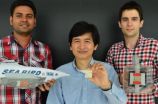(Press-News.org) Researchers at the University of Southern California (USC) have discovered a trigger by which the Hepatitis C virus enters liver cells ─ shedding light on how this serious and potentially deadly virus can begin to damage the liver.
The findings, reported in the Dec. 7, 2012 issue of the Journal of Biological Chemistry, may give scientists a target for future development of treatments for the virus.
In the early stages of a Hepatitis C Virus (HCV) infection, the researchers found, the virus binds to receptors on the liver cells' surface and activates PI3K and AKT, two proteins that control cell growth and metabolism, and which allow HCV to enter liver cells.
"When these two protein factors are activated, they trigger a cascade of reactions, altering the physiology of infected cells," said corresponding author and lead researcher James Ou, professor of molecular microbiology and immunology at the Keck School of Medicine of USC. "Later, by continuing to disturb this pathway, the virus may sensitize the liver cells to eventually become cancerous."
The findings were reported in a paper titled "Transient Activation of the PI3K-AKT Pathway by Hepatitis C Virus to Enhance Viral Entry." First author was Zhe Liu, a postdoctoral research associate in Ou's lab. Serving as co-investigators were Keck faculty members Keigo Machida, assistant professor of molecular microbiology and immunology, and Michael M.C. Lai, distinguished emeritus professor of microbiology and immunology, and neurology.
There are four-million carriers of HCV in the U.S. Often, people don't know that they have the virus until they already have some liver damage, which can take many years to develop. In time, the virus can lead to serious and deadly liver conditions: cirrhosis, a chronic, degenerative condition; cancer; and organ failure.
Some 20 percent of HCV patients will develop severe liver cirrhosis and may require liver transplantation, Ou noted. About five percent develop liver cancer after 20 to 30 years.
Ou has been studying HCV for 20 years and Hepatitis B virus for 30 years. The most recent study reflects his long-term interest in understanding the interactions between these two viruses and their host cells, and how they cause liver cancer.
"The next step, which we've just begun, is to understand how the activation of the
PI3K-AKT pathway allows the [HCV] virus to enter the cell," Ou said. "This research has led to the identification of a novel target for the development of new anti-HCV drugs. Compounds that disrupt the PI3K-AKT pathway are expected to prevent the virus from entering liver cells, causing the virus to disappear."
###
The research was supported, in whole or in part, by National Institutes of Health grants DK094652 and AI083025.
Keck School of Medicine of USC researchers find clue to how Hepatitis C virus harms liver
Study points scientists to target for future development of treatments
2012-12-12
ELSE PRESS RELEASES FROM THIS DATE:
Home visiting program for first-time moms may be struggling to reduce serious injuries to children
2012-12-12
New research from PolicyLab at The Children's Hospital of Philadelphia shows that one of the nation's largest programs providing home visitation support for at-risk mothers and children may not be as successful in reducing early childhood injuries as it was in earlier evaluations. The researchers evaluated the Nurse-Family Partnership (NFP) over seven years of widespread implementation in Pennsylvania and found that children served by the program had no fewer injuries than children in comparable families not enrolled in the program—and in some less serious cases, had higher ...
Discovery in Ghent could improve screening for sudden cardiac death
2012-12-12
ARVC is a hereditary heart condition in which the heart muscle (particularly the right ventricle) is partly replaced by fatty tissue and connective tissue. Cardiac arrhythmias can occur as a result of the changes in the heart muscle. Severe arrhythmias can cause dizziness or even lead to fainting or an acute cardiac arrest (= sudden death). ARVC is a progressive disease that usually presents during the teenage years.
Known mutations in desmosomal proteins
Mutations in various genes have already been linked to ARVC. These are primarily genes that are responsible for the ...
Economists calculate true value of 'who' you know, rather than 'what' in US politics
2012-12-12
Economists at the University of Warwick have calculated the true value of US political lobbyists, proving the old adage 'it is not what you know, but who you know'.
In a paper published this month in the American Economic Review Mirko Draca, from the University of Warwick's Department of Economics, looked at the role of lobbyists in the US. He found their revenue falls by 24% when their former employer leaves government office.
The study examined the so-called 'revolving door' of politics, which refers to the movement of people from government service into lobbying positions.
Mr ...
NTU's 'sense-ational' invention helps underwater vessels navigate with ease
2012-12-12
Nanyang Technological University (NTU) scientists have invented a 'sense-ational' device, similar to a string of 'feelers' found on the bodies of the Blind Cave Fish, which enables the fish to sense their surrounding and so navigate easily.
Using a combination of water pressure and computer vision technology, the sensory device is able to give users a 3-D image of nearby objects and map its surroundings. The possible applications of this fish-inspired sensor are enormous. The sensor can potentially replace the expensive 'eyes and ears' on Autonomous Underwater Vehicles ...
Tsunami caused long-term ecosystem change in the Caribbean
2012-12-12
A detailed analysis of sediments from the island of Bonaire in the Caribbean presents convincing evidence for an extraordinary wave impact dating back some 3,300 years, even though no historical records of tsunamis exist for this island. Of particular interest are the consequences this large wave impact had on the island's ecosystem. The sediments studied by the scientists suggested that this tsunami entirely changed the coastal ecosystem and sedimentation patterns in the area. The work by Dr. Max Engel and colleagues, from the University of Köln in Germany, is published ...
Advance in chromosomal evolution in sea cradles
2012-12-12
The study of chromosome changes arisen during species evolution is a current and intriguing topic that evolutionary biology proposes. However, in several groups (for example, molluscs), and chitons in particular, chromosome studies are scarce, with a few species investigated and analyses performed mostly with simple methods.
Only 2,5% of about 900 living species of chitons have been so far karyologically investigated, all of them in the same order (Chitonida). The authors note that the species of suborder Chitonina all have a karyotype of 2n=24 chromosomes, all biarmed, ...
'Smart stethoscope' advance in monitoring treatment of kidney stones
2012-12-12
A new listening device, developed by scientists from the University of Southampton, is being used to monitor the effectiveness of the treatment of kidney stones - saving patients unnecessary repeat therapy and x-ray monitoring.
If kidney stones cannot be dissolved by drugs, the favoured procedure is lithotripsy. Lithotripsy works by focusing thousands of shock waves onto the kidney stones in an effort to break them into pieces small enough to urinate out of the body or be dissolved by drugs.
However, it is difficult to discover exactly when the treatment has succeeded ...
Rice, Texas Children's team creates biocompatible patch to heal infants with birth defects
2012-12-12
A painstaking effort to create a biocompatible patch to heal infant hearts is paying off at Rice University and Texas Children's Hospital.
The proof is in a petri dish in Jeffrey Jacot's lab, where a small slab of gelatinous material beats with the rhythm of a living heart.
Jacot, lead author Seokwon Pok, a postdoctoral researcher at Rice, and their tissue-engineering colleagues have published the results ofyears of effort to produce a material called a bioscaffold that could be sutured into the hearts of infants suffering from birth defects. The scaffold, seeded with ...
Climate modelers see possible warmer, wetter Northeast winters by 2070
2012-12-12
AMHERST, Mass. – A new high-resolution climate study by University of Massachusetts Amherst climate scientists, the first to apply regional climate models to examine likely near-term changes in temperature and precipitation across the Northeast United States, suggests temperatures are going to be significantly warmer in all seasons in the next 30 years, especially in winter. Also, they project that winters will be wetter, with more rain likely than snow.
Writing in the current issue of the Journal of Geophysical Research, Michael Rawlins and Raymond Bradley of the Climate ...
UGA researchers find algal ancestor is key to how deadly pathogens proliferate
2012-12-12
Athens, Ga. – Long ago, when life on Earth was in its infancy, a group of small single-celled algae propelled themselves through the vast prehistoric ocean by beating whip like tails called flagella. It's a relatively unremarkable tale, except that now, more than 800 million years later, these organisms have evolved into parasites that threaten human health, and their algal past in the ocean may be the key to stopping them.
The organisms are called apicomplexa, but people know them better as the parasites that cause malaria and toxoplasmosis, serious diseases that infect ...
LAST 30 PRESS RELEASES:
The perfect plastic? Plant-based, fully saltwater degradable, zero microplastics
Bias in data may be blocking AI’s potential to combat antibiotic resistance
Article-level metrics would provide more recognition to most researchers than journal-level metrics
Satiety’s little helper: Protein that supports appetite regulating protein identified
UF dives deep into predicting storm damage with computer models
A stormy ocean voyage yields insights on the global carbon cycle
Scientists identify first non-coding gene that controls cell size
Demonstration of altermagnetism in RuO₂ thin films -- A new magnetic material for the AI era
Penn researchers awarded $25M to conduct trial using smartphones to fight heart disease
PCORI awards funding for new patient-centered healthcare research
Exploring the origins of the universe: 145 low-noise amplifiers complete ALMA telescopes
Empress cicada wings help illuminate molecular structure
Using sound waves to detect helium
Time burden in patients with metastatic breast and ovarian cancer from clinic and home demands
Researchers discover bias in AI models that analyze pathology samples
Scientists ID potential way to prevent brain injuries from triggering Alzheimer's
MASTER 2nd Open Call: Execution period kick-off
Algae for health in food and pharma
Advanced microrobots driven by acoustic and magnetic fields for biomedical applications
Chicago health information leader recognized for raising CPR readiness and blood pressure awareness
The Intimate Animal, a new book from Kinsey Institute Executive Director Dr. Justin Garcia
When blue-collar workers lose union protection, they try self-employment
New video dataset to advance AI for health care
MEA-based graph deviation network for early autism syndrome signatures in human forebrain organoids
New modeling approach sheds light on rare gut disease
Study documents potentially hazardous flame retardants in firefighter gear
Can certain bacteria regulate aging of the immune system and its related alterations?
AI model helps diagnose often undetected heart disease from simple EKG
There are fewer online trolls than people think
Cell membrane fluctuations produce electricity
[Press-News.org] Keck School of Medicine of USC researchers find clue to how Hepatitis C virus harms liverStudy points scientists to target for future development of treatments


